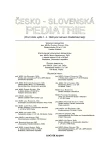-
Medical journals
- Career
Stevens–Johnson Syndrome and Toxic Epidermal Necrolysis in Children
Authors: E. Klásková 1; V. Smolka 1; J. Dobešová 2; J. Reitinger 1; J. Wiedermann 1; L. Vítková 1; E. Kaďůrková 1
Authors‘ workplace: JIRP, Dětská klinika, FN a LF UP, Olomouc přednosta prof. MUDr. V. Mihál, CSc. 1; Klinika chorob kožních a pohlavních, FN a LF UP, Olomouc přednostka doc. MUDr. D. Ditrichová, CSc. 2
Published in: Čes-slov Pediat 2007; 62 (1): 31-36.
Category: Case Report
Overview
Stevens–Johnson syndrome (SJS) and toxic epidermal necrolysis (TEN) are acute mucocutaneous diseases which become manifest as typical skin and mucous membrane lesions. It is etiologically a multi-factorial disease. The authors describe two case reports of patients with Stevens-Johnson syndrome and toxic epidermal necrolysis. A combined anti-epileptic treatment with lamotrigin, valproate and clonazepam was probably closely associated with the development of TEN in the first patient. In the second patient mycoplasma was the triggering moment in the development of SJS. An early diagnosis and correct therapy favorably influence the development of complications and mortality in the patients.
Key words:
Stevens-Johnson syndrome, toxic epidermal necrolysis, lamotrigin, mycoplasma infection
Labels
Neonatology Paediatrics General practitioner for children and adolescents
Article was published inCzech-Slovak Pediatrics

2007 Issue 1-
All articles in this issue
- Problems in Early Establishment of the Diagnosis of Severe Combined Immunodeficiency
- Mycoplasmal Pneumonia in Childhood
- Child Abuse and Neglect Syndrome (sy CAN) in Our Society and Medical Staff
- Stevens–Johnson Syndrome and Toxic Epidermal Necrolysis in Children
- Hypoplastic Left Heart Syndrome – cui bono? Review article
- Differential Diagnostics of Swelling at the Child Age
- Subtelomeric Rearrangement as a Cause of Microcephaly, Facial Dysmorphia and Mental Retardation
- Czech-Slovak Pediatrics
- Journal archive
- Current issue
- Online only
- About the journal
Most read in this issue- Mycoplasmal Pneumonia in Childhood
- Stevens–Johnson Syndrome and Toxic Epidermal Necrolysis in Children
- Subtelomeric Rearrangement as a Cause of Microcephaly, Facial Dysmorphia and Mental Retardation
- Child Abuse and Neglect Syndrome (sy CAN) in Our Society and Medical Staff
Login#ADS_BOTTOM_SCRIPTS#Forgotten passwordEnter the email address that you registered with. We will send you instructions on how to set a new password.
- Career

